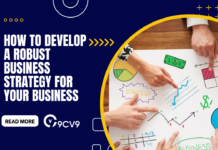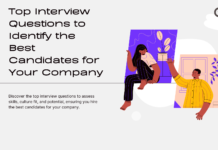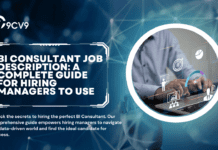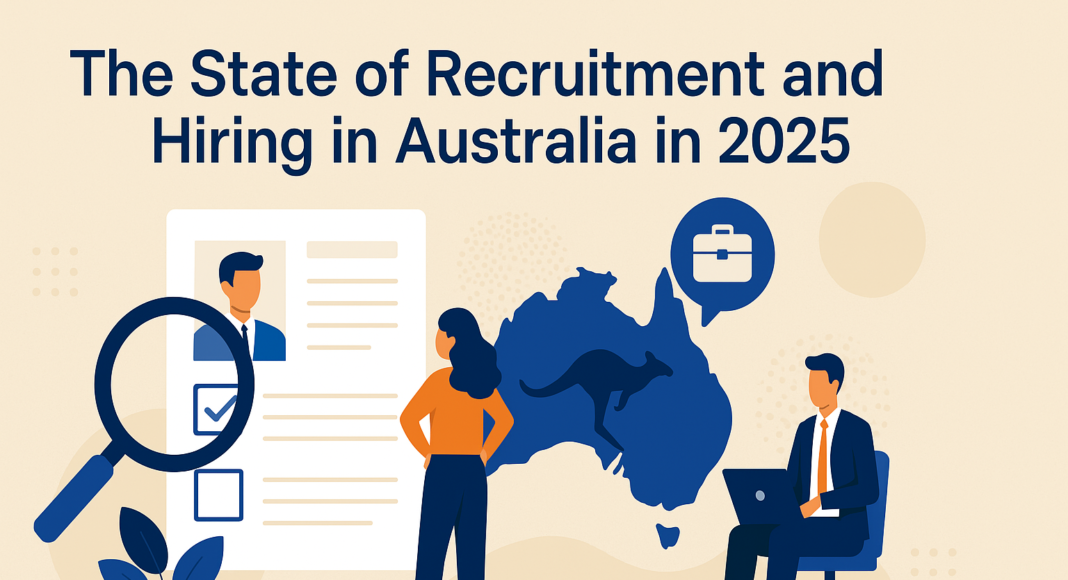Key Takeaways
- Skills shortages remain a major challenge – Industries like technology, healthcare, and engineering face critical talent gaps, driving demand for specialized skills.
- Flexible work and benefits drive job choices – Australian workers prioritize remote work, career growth, and well-being-focused benefits alongside competitive salaries.
- AI is reshaping recruitment – Automated hiring tools improve efficiency, but employers must address biases and refine hiring strategies to attract top talent.
The landscape of recruitment and hiring in Australia has undergone significant transformation in recent years, shaped by shifting economic conditions, technological advancements, evolving workforce expectations, and policy changes.
As we move through 2025, businesses, job seekers, and recruiters must navigate a dynamic job market influenced by automation, artificial intelligence (AI), remote work trends, and emerging skills demands.

Australia’s employment market remains highly competitive, with some industries facing talent shortages while others experience a surplus of skilled professionals.
Employers are adjusting their hiring strategies to attract, retain, and develop the right talent, while job seekers are re-evaluating their career paths in response to evolving job roles and workplace environments.
At the same time, government regulations, immigration policies, and labor laws continue to shape the recruitment process, requiring businesses to stay informed and adaptable.
Technology plays a crucial role in streamlining hiring practices, with AI-driven recruitment tools, applicant tracking systems (ATS), and data analytics helping employers find the best candidates more efficiently.
The growing emphasis on diversity, equity, and inclusion (DEI) has also pushed organizations to refine their hiring approaches, ensuring fair and unbiased selection processes that foster workplace diversity.
Meanwhile, the gig economy and freelance work continue to grow, influencing how companies source talent and structure employment contracts.
Another critical factor shaping recruitment in 2025 is the increasing demand for soft skills alongside technical expertise.
While automation and digital transformation have altered job requirements, employers are placing greater value on problem-solving abilities, adaptability, emotional intelligence, and teamwork.
The rise of hybrid and remote work arrangements has also necessitated a shift in hiring priorities, with companies seeking professionals who can collaborate effectively across digital platforms.
This blog explores the key trends, challenges, and opportunities in Australia’s recruitment and hiring sector in 2025.
From industry-specific hiring patterns to the role of AI in recruitment, policy updates, and workforce expectations, we delve into the factors shaping the Australian job market this year.
Whether you are an employer looking to refine your hiring strategy, a recruiter staying ahead of industry trends, or a job seeker planning your next career move, understanding the current state of recruitment will help you navigate this evolving landscape with confidence.
Stay with us as we break down the latest insights, expert opinions, and actionable takeaways to help you stay competitive in Australia’s 2025 hiring market.
Before we venture further into this article, we would like to share who we are and what we do.
About 9cv9
9cv9 is a business tech startup based in Singapore and Asia, with a strong presence all over the world.
With over nine years of startup and business experience, and being highly involved in connecting with thousands of companies and startups, the 9cv9 team has listed some important learning points in this overview of The State of Recruitment and Hiring in Australia in 2025.
If your company needs recruitment and headhunting services to hire top-quality employees, you can use 9cv9 headhunting and recruitment services to hire top talents and candidates. Find out more here, or send over an email to [email protected].
Or just post 1 free job posting here at 9cv9 Hiring Portal in under 10 minutes.
The State of Recruitment and Hiring in Australia in 2025
- The Australian Labor Market in 2025: Key Insights
- Emerging Trends Shaping Recruitment and Hiring in Australia
- The Growing Importance of Remote Hiring in 2025
- The Strategic Role of Employer Branding in 2025
- The Demand for Specific Skills and Roles Across Australian Industries in 2025
- Understanding Candidate Expectations in the Australian Job Market in 2025
- The Critical Role of Work-Life Balance in Australian Employment Trends (2025)
- The Growing Importance of Employee Benefits in Australia’s 2025 Job Market
- Challenges in Recruitment and Hiring in Australia (2025)
- Challenges in Talent Acquisition and Retention in Australia (2025)
- The Future of Recruitment and Hiring in Australia: 2025 and Beyond
1. The Australian Labor Market in 2025: Key Insights
Low Unemployment and Tight Labor Market
The Australian labor market remains resilient, with unemployment consistently low. Data from the Australian Bureau of Statistics (ABS) highlights:
- Unemployment Rate Stability: In February 2025, the unemployment rate stood at 4.0% (trend) and 4.1% (seasonally adjusted), mirroring figures from January.
- Fluctuations in Employment Levels: Trend employment in February reached 14,547,800, while seasonally adjusted employment declined slightly to 14,513,200 from 14,634,300 in January.
- Declining Participation Rate: The workforce participation rate dropped to 66.8% in February, down from 67.3% in January, suggesting workforce exits rather than an increase in unemployment.
Underemployment and Workforce Utilization
Underemployment measures the proportion of workers seeking additional hours. Key trends include:
- Lowest Underemployment Rate Since 2008: The underemployment rate fell to 5.9% in February 2025, the lowest level since August 2008.
- Greater Job Security: More workers are securing full-time or preferred working hours, reducing the availability of readily accessible labor.
Industry-Specific Labor Market Trends
Different sectors are experiencing varied hiring pressures:
- Healthcare and Aged Care: Continued demand for skilled professionals due to an aging population and increased government investment.
- Technology and IT: High demand for AI specialists, cybersecurity experts, and cloud computing professionals.
- Construction and Infrastructure: Skills shortages persist, particularly for engineers, tradespeople, and project managers.
- Retail and Hospitality: Workforce volatility continues, with seasonal hiring fluctuations and wage growth pressures.
Hiring Challenges for Employers in 2025
Talent Shortages and Workforce Gaps
- Skills shortages persist, particularly in STEM (Science, Technology, Engineering, and Mathematics) fields.
- Increased competition for highly skilled professionals has led to rising salary expectations and greater job mobility.
- The aging workforce is reducing the availability of experienced workers in certain industries.
Evolving Job Seeker Expectations
- More professionals seek flexible work arrangements, including remote and hybrid roles.
- Demand for higher wages and better benefits is reshaping employer offerings.
- Workplace culture, diversity, and career development opportunities are now critical factors in attracting talent.
Impact of Automation and AI on Hiring
- AI-powered recruitment tools are streamlining hiring processes but require companies to adapt to new technologies.
- Automation is transforming job roles, necessitating reskilling and upskilling initiatives.
Opportunities for Employers and Recruiters
Adapting Hiring Strategies for a Competitive Market
- Employer Branding: Companies that showcase strong workplace culture and employee benefits gain a competitive edge.
- Data-Driven Recruitment: Leveraging AI, predictive analytics, and talent acquisition software enhances hiring efficiency.
- Focus on Diversity and Inclusion: Businesses with inclusive hiring practices attract a broader talent pool and improve retention.
Leveraging Government and Policy Support
- Government programs supporting skilled migration and job training are essential in filling workforce gaps.
- Wage subsidies and grants for apprenticeships and training encourage workforce development.
The Rise of the Gig Economy and Contract Work
- More professionals are shifting towards freelance and contract roles, providing employers with flexible staffing solutions.
- Companies must adapt to hiring models that accommodate on-demand and project-based workforces.
Conclusion: The Future of Hiring in Australia
The Australian labor market in 2025 presents both challenges and opportunities for businesses and job seekers. While employers face a tight labor market and skills shortages, innovative recruitment strategies, upskilling initiatives, and government support provide pathways to securing top talent. As technology reshapes the hiring process and job seekers demand more from their workplaces, companies that adapt to these evolving trends will thrive in an increasingly competitive environment.
By understanding these recruitment dynamics, businesses can make informed decisions to attract, hire, and retain the right talent in Australia’s ever-changing employment landscape.
2. Emerging Trends Shaping Recruitment and Hiring in Australia
1. The Rise of AI in Recruitment and Talent Acquisition
Artificial intelligence (AI) has become a critical component of modern recruitment strategies, moving from an experimental phase to an essential operational tool. By 2025, AI is fundamentally reshaping how companies attract, assess, and hire talent.
How AI is Enhancing Recruitment Efficiency
- Automation of Repetitive Tasks: AI is increasingly used for automating high-volume tasks such as resume screening, job matching, and candidate outreach. This allows recruiters to focus on strategic decision-making and relationship-building.
- Improved Candidate Sourcing: AI-driven platforms analyze large datasets to identify candidates with the right skills and experience, leading to more targeted hiring.
- Predictive Analytics for Hiring Success: AI tools are now capable of assessing a candidate’s likelihood of success in a role based on historical hiring data and behavioral insights.
Challenges and Ethical Considerations in AI-Driven Recruitment
While AI significantly improves efficiency, its adoption also raises concerns about fairness and bias in hiring.
- Risk of Algorithmic Bias: If AI models are trained on biased data, they may unintentionally reinforce discrimination in hiring decisions.
- Need for Human Oversight: Organizations must ensure AI tools are used as decision-support systems rather than as sole arbiters of hiring outcomes.
- Transparency in AI Hiring Decisions: Ethical AI implementation requires clear guidelines on how AI-driven hiring decisions are made and validated.
AI’s Impact on Workforce Skills Demand
- AI’s expansion in recruitment is driving a surge in demand for professionals skilled in machine learning, data science, and cybersecurity.
- Businesses are investing in upskilling initiatives to equip employees with AI-related competencies.
- AI is not only revolutionizing hiring but also transforming other HR functions such as employee engagement, payroll automation, and workforce management.
2. Changing Job Seeker Expectations in 2025
The workforce in 2025 has different priorities compared to previous years, compelling employers to adapt their recruitment strategies to meet evolving expectations.
Shift Towards Flexible and Hybrid Work Models
- Remote Work Normalization: The demand for remote and hybrid work arrangements remains high, with job seekers prioritizing flexibility over traditional office-based roles.
- Work-Life Balance Considerations: Employers offering flexible schedules and wellness programs have a competitive advantage in attracting top talent.
- Rising Demand for Four-Day Work Weeks: Some industries are experimenting with reduced workweeks to improve productivity and employee satisfaction.
Emphasis on Employer Branding and Workplace Culture
- Company Values and Social Responsibility: Candidates are increasingly drawn to employers with strong commitments to sustainability, ethical business practices, and diversity initiatives.
- Career Growth and Learning Opportunities: Job seekers are prioritizing roles that offer professional development, mentorship programs, and continuous learning.
- Transparency in Compensation and Benefits: Competitive salary packages, health benefits, and performance-based incentives are critical in securing top talent.
3. Skills Shortages and the Demand for Specialized Talent
Despite a stable unemployment rate, Australia faces acute skills shortages in key sectors, driving competition among employers.
Industries Most Affected by Skills Gaps
- Technology and Cybersecurity: The rise of AI and digital transformation has intensified demand for software engineers, data analysts, and cybersecurity specialists.
- Healthcare and Aged Care: With an aging population, Australia continues to see shortages of nurses, aged care professionals, and medical specialists.
- Engineering and Infrastructure: Government-backed construction and infrastructure projects are driving demand for civil engineers, electricians, and project managers.
- Renewable Energy and Sustainability: The push towards clean energy is fueling demand for green technology experts, solar engineers, and environmental scientists.
Strategies to Address Skills Shortages
- Increased Investment in Upskilling Programs: Employers are partnering with educational institutions to provide industry-specific training.
- Expansion of Skilled Migration Programs: The Australian government is adjusting visa policies to attract international talent to fill labor shortages.
- Enhanced Internal Mobility Programs: Companies are promoting internal career growth by reskilling existing employees for high-demand roles.
4. The Evolution of Recruitment Strategies in 2025
To remain competitive in the current job market, companies are rethinking their hiring approaches.
Data-Driven Recruitment and Predictive Hiring
- AI-Powered Talent Analytics: Employers are leveraging real-time workforce data to predict hiring needs and reduce turnover rates.
- Behavioral Assessments and Skill-Based Hiring: Organizations are moving away from traditional resumes and degrees, focusing more on skills-based hiring and problem-solving abilities.
Diversity, Equity, and Inclusion (DEI) in Hiring
- Structured Hiring Practices: Businesses are implementing standardized interview frameworks to minimize unconscious bias.
- DEI-Optimized Job Descriptions: Inclusive language and outreach strategies are being used to attract diverse talent pools.
- Neurodiverse and Disability-Inclusive Hiring: More companies are adjusting their recruitment processes to support neurodivergent and disabled candidates.
Expansion of the Gig Economy and Contract Work
- Growth of Freelance and Project-Based Roles: Many professionals are shifting towards independent contracting, offering businesses access to specialized skills on-demand.
- Rise of On-Demand Workforce Platforms: Digital staffing platforms are streamlining how businesses connect with contract workers for short-term projects.
Conclusion: The Future of Hiring in Australia
Recruitment and hiring in Australia are undergoing profound changes in 2025, influenced by AI adoption, shifting workforce expectations, and industry-wide skills shortages. Companies that embrace technology-driven recruitment, prioritize diversity and inclusion, and offer flexible work arrangements will have a significant advantage in attracting and retaining top talent.
As the employment landscape continues to evolve, businesses must remain agile, leveraging data-driven insights and innovative hiring practices to navigate the future of work successfully. In an era of rapid transformation, staying ahead in recruitment requires continuous adaptation, investment in people, and a commitment to ethical and inclusive hiring practices.
3. The Growing Importance of Remote Hiring in 2025
1. The Shift Towards Remote and Hybrid Work Models
Remote work has transitioned from a temporary pandemic-driven solution to a permanent fixture in the Australian employment landscape. Companies that embrace flexible working arrangements are better positioned to attract and retain skilled professionals.
Key Drivers of Remote Work Adoption
- Employee Demand for Flexibility: A significant portion of the workforce now considers remote and hybrid work options essential when evaluating job opportunities.
- Increased Productivity and Work-Life Balance: Many employees report higher job satisfaction, reduced commuting stress, and improved efficiency when working remotely.
- Employer Adaptation to Talent Expectations: Organizations that fail to offer remote or hybrid options may struggle to compete for top-tier candidates.
2. The Role of Technology in Facilitating Remote Hiring
Advancements in AI, automation, and virtual collaboration tools are enabling companies to manage remote teams and conduct hiring processes more efficiently.
AI and Digital Tools Enhancing Remote Work
- AI-Driven Recruitment Platforms: AI-powered applicant tracking systems (ATS) help streamline virtual hiring by automating resume screening, job matching, and initial candidate assessments.
- Virtual Interviewing Solutions: Video conferencing platforms with AI-driven features, such as real-time language translation and automated interview summaries, improve the hiring experience.
- Remote Performance Analytics: AI tools analyze remote employee productivity and engagement, helping employers optimize work-from-home models.
3. Expansion of the Talent Pool Beyond Geographic Limits
One of the most significant advantages of remote hiring is the ability to access a broader talent pool. Organizations are no longer restricted to hiring within specific regions, allowing them to attract highly skilled professionals from across Australia and even internationally.
Benefits of an Expanded Talent Pool
- Addressing Skills Shortages: Remote hiring enables companies to fill roles in high-demand industries such as technology, finance, and healthcare without being constrained by local labor market limitations.
- Enhanced Workforce Diversity: Organizations can recruit individuals from various backgrounds, fostering inclusivity and diverse perspectives.
- Cost Savings on Office Space and Relocation: Companies with remote-first policies can reduce overhead costs and offer competitive salaries without relocation expenses.
4. Generational and Workforce Preferences in Remote Work
While remote work is widely accepted, different generations and workforce segments have varying preferences regarding flexible work arrangements. Employers must tailor their policies to meet diverse expectations.
Understanding Workforce Demographics and Preferences
- Millennials and Gen Z: Younger professionals value digital connectivity, flexibility, and work-life balance. They prefer hybrid models that allow social interaction alongside remote work.
- Generation X: This demographic often seeks career stability and values remote work as a way to manage personal and family commitments.
- Baby Boomers: While some prefer traditional work settings, many appreciate the option of flexible hours rather than fully remote roles.
Employers that recognize these generational nuances can create adaptable policies that appeal to a diverse workforce.
Challenges and Considerations in Remote Hiring
1. Maintaining Company Culture and Employee Engagement
A key concern with remote hiring is ensuring that employees remain connected to the organization’s culture and mission. Without in-person interactions, businesses must find alternative ways to foster team cohesion.
Strategies to Strengthen Remote Workplace Culture
- Virtual Team-Building Activities: Regular online social events and collaborative projects help remote employees stay engaged.
- Strong Onboarding Programs: Structured virtual onboarding ensures new hires integrate smoothly into the company culture.
- Clear Communication Channels: Employers must invest in digital communication tools to keep teams aligned and informed.
2. Cybersecurity and Data Protection in Remote Work
With more employees working remotely, businesses must address potential cybersecurity risks.
Key Cybersecurity Measures for Remote Teams
- Enhanced IT Security Protocols: Organizations must implement multi-factor authentication, encrypted communication, and VPN access for remote workers.
- Employee Training on Cybersecurity: Regular training programs help employees identify phishing attempts and other security threats.
- Secure Cloud-Based Collaboration Tools: Businesses should use verified, secure platforms for file sharing and project management.
3. Performance Monitoring and Accountability
Managing remote employees requires a balance between trust and accountability. Over-surveillance can reduce morale, while insufficient oversight may lead to decreased productivity.
Effective Remote Performance Management Strategies
- Outcome-Based Performance Metrics: Employers should focus on results rather than micromanaging work hours.
- Regular Check-Ins and Feedback Sessions: Frequent virtual meetings keep employees aligned with company goals.
- Utilization of AI for Workload Analysis: AI-driven tools can assess productivity trends without intrusive monitoring.
The Future of Remote Hiring in Australia
As remote hiring practices continue to evolve, organizations must remain agile and adaptable. The companies that successfully implement remote work strategies will benefit from a larger talent pool, improved employee retention, and a more inclusive workforce.
To thrive in the changing employment landscape, businesses must:
- Invest in AI-driven recruitment and virtual collaboration tools to optimize hiring and team management.
- Adopt flexible work policies that cater to diverse workforce preferences.
- Enhance cybersecurity measures to protect company and employee data.
- Prioritize company culture and employee engagement to maintain a strong remote workforce.
Remote hiring is no longer an emerging trend—it is a fundamental aspect of recruitment and workforce management in 2025. By leveraging technology, embracing flexibility, and fostering inclusive workplace practices, Australian businesses can stay ahead in the evolving job market.
4. The Strategic Role of Employer Branding in 2025
1. Why Employer Branding Matters More Than Ever
Employer branding is no longer an optional element of recruitment but a fundamental necessity in 2025. Candidates now actively research companies before applying, using online resources such as company review sites, social media, and employee testimonials to assess workplace culture and values.
Key Reasons Why Employer Branding is Critical:
- Competitive Talent Market: Skilled professionals have multiple options, making it essential for companies to stand out.
- Candidate Expectations Have Evolved: Job seekers prioritize company culture, flexibility, diversity, and career growth opportunities when evaluating potential employers.
- Impact on Hiring Costs and Retention: Organizations with strong employer brands attract higher-quality applicants, reduce hiring costs, and experience lower turnover rates.
- Influence on Business Performance: A positive employer reputation enhances customer trust, investor confidence, and overall brand perception.
2. How Candidates Evaluate Employers in 2025
The decision-making process for job seekers has become more sophisticated, with candidates seeking transparency and authenticity in employer communications.
Key Factors Candidates Consider When Assessing an Employer:
- Company Reputation and Online Presence: Employer review platforms (e.g., Glassdoor, SEEK company reviews) heavily influence perceptions.
- Workplace Culture and Employee Experiences: Candidates look for real stories from employees via LinkedIn, blogs, and video testimonials.
- Career Development Opportunities: Organizations that invest in upskilling, mentorship, and career progression gain a competitive edge.
- Commitment to Diversity, Equity, and Inclusion (DEI): Inclusive workplaces attract a broader talent pool and improve employer attractiveness.
- Work-Life Balance and Flexibility: The rise of remote and hybrid work means flexibility is a top priority for candidates.
Key Strategies for Building a Strong Employer Brand
1. Developing an Authentic Employee Value Proposition (EVP)
A well-defined Employee Value Proposition (EVP) serves as the foundation of a strong employer brand, clearly articulating the unique benefits and experiences that employees receive in exchange for their contributions.
Essential Components of an Effective EVP:
- Competitive Compensation and Benefits: Salary alone is not enough—employers must highlight healthcare, bonuses, paid leave, and additional perks.
- Career Growth and Learning Opportunities: Employees seek organizations that invest in their professional development through training, leadership programs, and upskilling initiatives.
- Supportive and Inclusive Workplace Culture: A company that fosters collaboration, recognition, and a sense of belonging is more attractive to job seekers.
- Work-Life Balance and Well-Being Initiatives: Employers that emphasize flexible work options, mental health support, and employee wellness programs enhance their appeal.
- Commitment to Social Responsibility: Companies with strong corporate social responsibility (CSR) programs attract purpose-driven employees who value ethical and sustainable business practices.
2. Leveraging Digital Platforms for Employer Branding
Organizations must proactively manage their online presence to maintain a positive reputation and attract top candidates.
Best Practices for Digital Employer Branding:
- Maintain an Engaging Careers Page: The company website should showcase employee stories, company culture, job opportunities, and workplace benefits.
- Optimize LinkedIn and Social Media Presence: Sharing employee success stories, workplace achievements, and company initiatives helps build trust with potential candidates.
- Encourage Employee Advocacy: Employees should be encouraged to share their experiences on platforms like Glassdoor, LinkedIn, and social media.
- Use Video and Visual Content: Video testimonials from employees provide a more authentic and relatable insight into workplace culture.
3. Enhancing Employee Experience to Strengthen Brand Perception
A strong employer brand is built from within—happy and engaged employees become the most effective ambassadors for a company.
Ways to Improve Employee Experience:
- Implement Regular Employee Feedback Programs: Conduct surveys and focus groups to understand employee satisfaction and areas for improvement.
- Recognize and Reward Employee Contributions: Public recognition, bonuses, and career growth opportunities contribute to higher engagement.
- Create a Culture of Inclusivity and Belonging: Diversity and inclusion initiatives should be integrated into the company’s core values.
- Offer Meaningful Work and Purpose-Driven Initiatives: Employees who feel their work has a positive impact are more likely to remain loyal to the organization.
The Impact of Employer Branding on Recruitment Success
1. How a Strong Employer Brand Reduces Hiring Costs
Organizations that invest in employer branding strategies experience tangible benefits in their recruitment efforts.
Measurable Advantages:
- Higher Number of Quality Applicants: A well-regarded employer brand naturally attracts top talent without excessive recruitment spending.
- Lower Employee Turnover Rates: Engaged employees who align with company values are more likely to remain long-term.
- Reduced Time-to-Hire: Strong employer brands experience faster hiring processes as candidates are more willing to accept offers.
- Increased Employee Referral Rates: Satisfied employees are more likely to recommend their workplace to peers, reducing the need for external recruitment efforts.
2. The Role of Employer Branding in Talent Retention
Employer branding is not just about attracting new hires—it plays a critical role in retaining existing employees.
Key Retention Strategies Through Employer Branding:
- Consistently Deliver on EVP Promises: Employees should experience the benefits and culture that were advertised during recruitment.
- Invest in Employee Career Development: Companies that provide clear career growth paths retain talent more effectively.
- Foster a Positive Workplace Culture: An environment of trust, transparency, and support encourages long-term commitment.
The Future of Employer Branding in Australia
Looking ahead, employer branding will continue to shape the recruitment landscape in Australia. Organizations that prioritize transparency, employee experience, and digital engagement will remain competitive in attracting and retaining talent.
Key Takeaways for Employers in 2025:
- Employer branding is a long-term investment, not a short-term campaign.
- Companies that showcase authenticity and employee well-being will stand out.
- Digital platforms and AI-driven recruitment tools will further influence employer perception.
- A strong EVP is essential for attracting and retaining top talent.
In the evolving Australian job market, employer branding is no longer just about recruitment—it is a strategic imperative that impacts overall business success. Companies that embrace these principles will position themselves as employers of choice, gaining a significant edge in hiring and workforce retention.
5. The Demand for Specific Skills and Roles Across Australian Industries in 2025
The Australian labor market in 2025 continues to evolve, reflecting both long-standing industry trends and emerging economic demands. As businesses across sectors adapt to technological advancements, demographic shifts, and global influences, certain skills and roles are experiencing heightened demand.
Understanding these workforce dynamics is essential for job seekers, employers, policymakers, and educational institutions. Identifying the most sought-after skills and professions enables professionals to align their career development with market needs, while businesses can refine their recruitment strategies to attract and retain top talent.
Key Industry Sectors with High Demand for Talent
1. Growth in the Healthcare and Social Assistance Sector
The Healthcare and Social Assistance sector continues to be Australia’s largest and fastest-growing industry in 2025, driven by an aging population, increased healthcare needs, and a growing focus on mental health services.
Key Roles in Demand:
- Registered Nurses and Aged Care Workers – With a rising elderly population, aged care professionals are increasingly needed to provide quality care.
- General Practitioners (GPs) and Medical Specialists – The demand for healthcare professionals remains high, particularly in regional and remote areas.
- Mental Health Professionals and Allied Health Workers – The emphasis on mental health has led to greater demand for psychologists, therapists, and social workers.
Industry Drivers:
- Government funding for aged care reforms and mental health initiatives.
- Advances in telehealth and digital healthcare solutions.
- Population growth and increased demand for preventative healthcare services.
2. Expansion in the Education and Training Industry
Australia’s Education and Training sector continues to grow, particularly as workforce upskilling becomes a national priority. The need for qualified teachers, vocational trainers, and higher education lecturers remains strong.
Key Roles in Demand:
- Primary and Secondary School Teachers – Increased student enrollment, particularly in STEM (Science, Technology, Engineering, Mathematics) fields, is driving demand.
- Vocational Education and Training (VET) Instructors – The government is investing in technical and trade education, increasing the demand for trainers in construction, IT, and healthcare-related fields.
- University Lecturers and Researchers – Higher education institutions require experts in AI, cybersecurity, and emerging technologies.
Industry Drivers:
- A push towards digital education and remote learning solutions.
- Increasing international student enrollments in vocational and tertiary education.
- Strong demand for teacher workforce diversification and special education experts.
3. The Rise of the Technology and IT Sector
The digital economy is a key driver of Australia’s workforce landscape, with Information Technology (IT) and Digital Transformation shaping the demand for highly skilled professionals. Companies across industries are investing in AI, cloud computing, cybersecurity, and data analytics.
Key Roles in Demand:
- Software Engineers and Developers (Python, Java, C++) – Specialists in web, mobile, and AI-driven applications remain in high demand.
- Cybersecurity Analysts – Growing concerns over cyber threats have led to increased recruitment of professionals to safeguard digital assets.
- Cloud Engineers and IT Infrastructure Specialists – Companies are transitioning to cloud-based services, increasing the need for AWS, Google Cloud, and Microsoft Azure experts.
- Data Scientists and AI Specialists – Businesses rely on data-driven insights for decision-making, boosting demand for machine learning engineers and big data analysts.
Industry Drivers:
- Australian businesses embracing automation and digital transformation.
- Growing need for cyber resilience across financial, healthcare, and government sectors.
- Expansion of AI-driven recruitment and HR technology solutions.
4. High Demand for Skilled Trades and Construction Workers
Australia’s Construction and Trades sector remains a crucial part of the economy, with demand for infrastructure development, residential housing, and commercial projects fueling the need for skilled workers.
Key Roles in Demand:
- Electricians, Plumbers, and Carpenters – Trade professionals are experiencing steady demand across both urban and regional areas.
- Civil and Structural Engineers – Infrastructure projects, including transportation and renewable energy developments, require experienced engineers.
- Project Managers and Site Supervisors – As construction activity increases, leadership roles in project execution and compliance are in high demand.
Industry Drivers:
- Government-funded infrastructure projects, including roads, railways, and renewable energy installations.
- The need for sustainable building practices and environmentally friendly construction materials.
- A shortage of trade professionals, leading to increased wages and career opportunities.
5. Growth in Finance and Accounting Professions
Despite economic uncertainties, the Financial Services sector continues to require skilled professionals in risk management, compliance, and corporate finance.
Key Roles in Demand:
- Financial Analysts and Accountants – Businesses require financial expertise to navigate inflation, interest rate changes, and investment risks.
- Risk and Compliance Managers – The rise of regulatory frameworks and governance standards has led to increased hiring of compliance specialists.
- Investment and Wealth Management Professionals – A growing interest in cryptocurrency, ESG (Environmental, Social, and Governance) investing, and financial planning is reshaping the financial services sector.
Industry Drivers:
- The need for digital banking, fintech innovation, and blockchain expertise.
- A focus on corporate sustainability and ethical investing.
- Increased financial regulations, requiring skilled regulatory professionals.
The Growing Importance of Skills-Based Hiring in 2025
Beyond specific job roles, skills-based hiring is becoming a dominant recruitment trend, with employers prioritizing technical and soft skills over formal qualifications.
1. Most In-Demand Skills in 2025
Technology and Digital Skills:
- Artificial Intelligence (AI) and Machine Learning
- Cybersecurity and Ethical Hacking
- Cloud Computing (AWS, Google Cloud, Azure)
- Big Data Analytics and Business Intelligence
Socio-Emotional and Workplace Skills:
- Critical Thinking and Problem-Solving
- Adaptability and Digital Literacy
- Collaboration and Cross-Functional Teamwork
- Leadership and Decision-Making
Trade and Industry-Specific Skills:
- Electrical and Mechanical Engineering Expertise
- Advanced Manufacturing and Robotics
- Project Management and Agile Methodologies
- Sustainable Development and Green Energy Skills
2. The Shift Toward Continuous Learning and Upskilling
With rapid technological advancements and changing job market conditions, upskilling and reskilling have become essential for both employees and employers.
Key Trends in Upskilling:
- Short-term certification programs in high-demand fields like AI, cybersecurity, and cloud computing.
- Corporate-sponsored training programs to bridge internal skill gaps.
- Government-funded initiatives supporting vocational training and professional development.
Conclusion: Navigating Australia’s Evolving Job Market
The Australian labor market in 2025 is shaped by technological advancements, demographic changes, and evolving industry needs. Job seekers who align their skills with high-demand professions in healthcare, technology, finance, education, and skilled trades will have the greatest career opportunities.
For employers, the challenge lies in adapting recruitment strategies to attract digitally skilled, adaptable, and diverse talent. A data-driven approach to hiring, a focus on employer branding, and investment in employee development will be key differentiators in securing top talent.
By staying informed on workforce trends, both job seekers and employers can successfully navigate Australia’s dynamic employment landscape and capitalize on emerging opportunities in 2025.
6. Understanding Candidate Expectations in the Australian Job Market in 2025
As Australia’s labor market evolves in 2025, job seekers are placing greater emphasis on a holistic employment experience, moving beyond just job titles and responsibilities. Candidates today prioritize a combination of competitive compensation, work-life balance, career development opportunities, and employer values when evaluating job offers. Employers who align with these expectations will be better positioned to attract and retain top talent in an increasingly competitive hiring landscape.
The Role of Compensation in Attracting Talent
1. Salary Trends and Forecasts for 2025
The post-pandemic period saw rapid wage growth across several industries, primarily driven by intense competition for skilled professionals. However, in 2025, the trajectory of salary growth appears to be moderating as labor market conditions stabilize.
Key Salary Trends:
- The Australian Industry Group reported a slowdown in wage growth during the December quarter of 2024, with forecasts predicting a gradual decline in salary increments into 2025-2026.
- Mercer’s 2024 Total Remuneration Survey indicated that most industries experienced smaller salary increases in 2024 compared to 2023, and conservative salary adjustments are expected to continue in 2025.
- Despite the slowdown in overall wage growth, salary remains the top priority for job seekers, particularly those affected by the rising cost of living.
2. The Importance of Competitive Pay in Talent Retention
Salary remains the primary motivator for job seekers in 2025, with a majority of professionals actively seeking higher compensation.
Insights from Market Research:
- Robert Half’s 2025 Workforce Report found that 62% of Australian workers rank a pay raise among their top three priorities, with nearly a third identifying it as their number one career goal for the year.
- Millennials are particularly focused on salary growth, reflecting their financial concerns and aspirations for career progression.
- KPMG’s 2025 Labor Market Review highlighted that higher wages contribute to increased workforce participation, demonstrating that competitive compensation is essential for attracting passive job seekers and retaining existing employees.
Industry-Specific Salary Trends and Geographic Variations
1. High-Demand Skills Commanding Premium Salaries
Not all industries are experiencing wage stagnation. Sectors with persistent skills shortages continue to offer competitive salary increases to attract specialized talent.
Roles with Significant Salary Growth in 2025:
- Technology Sector: Professionals in Cybersecurity, AI/Machine Learning, and Data Science remain in high demand, with salaries outpacing national averages due to ongoing skills shortages.
- E-Commerce and Financial Services: According to EY’s 2025 Employment Report, salaries in these industries are projected to rise by an average of 9.4%, reflecting the rapid digital transformation and fintech expansion.
- Healthcare and Engineering: Medical professionals, engineers, and construction managers continue to receive above-average salary increases, particularly in regional and remote areas where demand outstrips supply.
2. Geographic Salary Differences Across Australia
Salaries in Australia vary based on location, cost of living, and industry demand. Employers must tailor their compensation packages based on regional differences to remain competitive.
Key Regional Salary Insights:
- Sydney and Melbourne typically offer higher salaries compared to other cities, reflecting their higher living costs and concentration of corporate headquarters.
- Brisbane and Perth have seen salary growth in mining, energy, and infrastructure roles, aligning with continued investment in natural resources and renewable energy projects.
- Regional Australia offers competitive wages in healthcare, education, and skilled trades, particularly due to government incentives aimed at addressing worker shortages in remote areas.
Beyond Salary: The Rising Importance of Benefits and Work-Life Balance
1. The Shift Toward Total Compensation Packages
While salary remains a crucial factor, job seekers in 2025 are increasingly evaluating total compensation packages, which include benefits, workplace flexibility, and career growth opportunities.
Top Employee Benefits in Demand:
- Flexible Work Arrangements – Hybrid and remote work remain major deciding factors for job seekers. Companies that do not offer flexibility risk losing top candidates.
- Wellness and Mental Health Support – Employees expect mental health programs, employee assistance plans, and wellness stipends as part of their benefits package.
- Upskilling and Career Development – Access to professional development programs, industry certifications, and mentorship opportunities has become a key differentiator in employer attractiveness.
2. The Influence of Work Culture and Employer Branding
Modern job seekers are looking for more than just financial incentives—they also seek alignment with an organization’s culture, values, and work environment.
Key Employer Branding Considerations:
- Diversity, Equity, and Inclusion (DEI): Companies with strong DEI policies attract a broader and more engaged talent pool.
- Sustainability and Corporate Social Responsibility: Employees are increasingly prioritizing eco-conscious employers and companies that engage in social impact initiatives.
- Transparent Leadership and Employee Engagement: Organizations that communicate openly, foster innovation, and support employee well-being stand out in a competitive hiring landscape.
Conclusion: Adapting to Evolving Candidate Expectations
In 2025, understanding and addressing candidate expectations is essential for Australian employers to secure top talent. While competitive salaries remain a primary factor in job selection, organizations must also invest in workplace benefits, career development, and a strong employer brand to attract and retain a highly skilled workforce.
Key takeaways for employers navigating recruitment in 2025 include:
✔️ Offering industry-aligned salaries to stay competitive in high-demand sectors.
✔️ Implementing flexible work policies to meet evolving employee preferences.
✔️ Enhancing benefits packages with wellness programs, career growth opportunities, and DEI initiatives.
✔️ Building a strong employer brand to create long-term workforce stability.
By aligning their recruitment and retention strategies with employee priorities, businesses in Australia can successfully navigate the shifting job market and build a future-ready workforce.
7. The Critical Role of Work-Life Balance in Australian Employment Trends (2025)
In 2025, work-life balance has evolved from a desirable perk to an essential expectation for employees across Australia. The modern workforce places greater emphasis on personal well-being, job satisfaction, and the ability to seamlessly integrate their professional and personal responsibilities. Employers who fail to accommodate these expectations risk losing top talent in an increasingly competitive job market.
The Increasing Demand for Work-Life Balance in the Australian Workforce
1. The Evolution of Work-Life Balance from a Perk to a Necessity
- Employees now view work-life balance as a non-negotiable factor when evaluating job opportunities.
- Organizations that emphasize well-being and flexibility gain a stronger employer brand and attract higher-quality candidates.
- Work-life balance has a direct correlation with productivity, engagement, and job satisfaction, making it a key driver of employee retention.
2. The Connection Between Flexibility and Work-Life Balance
- The increasing demand for hybrid and remote work models is largely driven by the pursuit of better work-life balance.
- Flexible work schedules provide employees with greater autonomy, allowing them to effectively manage both professional and personal commitments.
- Research findings indicate that Australian workers consistently rank flexible work arrangements as one of the most valuable employee benefits in 2025.
The Competitive Advantage of a Supportive Work Environment
1. How Work-Life Balance Impacts Employee Satisfaction
- Organizations that prioritize employee well-being foster greater job satisfaction and commitment.
- Offering adequate paid time off, mental health support, and wellness programs can enhance an employer’s reputation and appeal.
- Companies that actively respect employees’ personal time are more likely to see improved employee engagement and loyalty.
2. Understanding Generational Differences in Work-Life Balance Preferences
- Different age groups have unique expectations regarding work-life balance and flexibility.
- Baby Boomers tend to prefer flexible work hours, while Millennials and Gen Z often prioritize remote work options and mental health benefits.
- Employers who recognize and adapt to these diverse workforce needs can implement customized work policies to enhance retention and job satisfaction.
Work-Life Balance as a Key to Attracting and Retaining Talent in 2025
- In a candidate-driven job market, offering work-life balance initiatives is crucial for securing top talent.
- Employers who fail to implement flexible and supportive work policies may struggle with high turnover rates and lower employee engagement.
- Proactively addressing work-life balance concerns through policy adjustments, cultural shifts, and wellness programs positions organizations for long-term success.
Final Thoughts
As work-life balance becomes a core expectation rather than a secondary consideration, Australian businesses must adapt their workplace policies to reflect employee priorities. Those that invest in flexible work arrangements, employee well-being initiatives, and a supportive workplace culture will gain a significant competitive advantage in 2025’s evolving job market.
8. The Growing Importance of Employee Benefits in Australia’s 2025 Job Market
In 2025, Australian employees are increasingly prioritizing comprehensive benefits packages that extend beyond traditional salaries. While competitive pay remains essential, job seekers now place greater value on benefits that enhance work-life balance, support overall well-being, and promote career development. Employers who recognize and adapt to these evolving expectations are better positioned to attract and retain top talent in an increasingly competitive labor market.
The Shift Towards Work-Life Balance as a Core Employee Expectation
1. The Growing Importance of Workplace Flexibility
- Flexibility has overtaken salary as a leading factor influencing job satisfaction among Australian employees.
- Employers are increasingly offering hybrid work models, remote work options, compressed workweeks, and flexible scheduling to accommodate employees’ diverse needs.
- Companies that prioritize flexible work arrangements benefit from higher employee engagement, reduced turnover rates, and improved workplace morale.
2. The Role of Leave Policies in Employee Satisfaction
- Additional paid leave options, such as birthday leave, volunteer leave, and mental health days, are becoming more common.
- Parental leave policies are evolving, with many companies extending paid leave durations and offering more inclusive policies to support all caregivers.
- Employers that offer generous leave benefits are perceived as more attractive to job seekers, particularly among younger generations entering the workforce.
The Growing Demand for Well-Being and Financial Support Benefits
1. The Rising Need for Comprehensive Health Benefits
- Health insurance remains one of the most sought-after benefits, especially as healthcare costs continue to rise.
- Employers are expanding mental health support programs, including counseling services, wellness stipends, and employee assistance programs (EAPs).
- On-site or virtual health services, such as telehealth consultations and fitness memberships, are increasingly integrated into employee benefits packages.
2. Financial Security as a Workplace Priority
- Employees are showing greater interest in financial wellness programs, such as retirement savings plans, superannuation contributions, and budgeting assistance.
- Earned wage access, cashback offers, and financial planning resources help employees manage their finances more effectively.
- Employers who provide strong financial wellness initiatives create a workforce that is more financially stable, engaged, and productive.
Career Growth and Development as a Key Retention Strategy
1. Investing in Learning and Professional Advancement
- Employees now expect ongoing training, mentorship, and skill development opportunities from their employers.
- Companies offering structured career progression plans attract and retain ambitious professionals seeking long-term growth.
- Upskilling programs in emerging fields such as cybersecurity, artificial intelligence, and data science are particularly valuable in 2025’s evolving job market.
2. Personalized and Customizable Benefits Programs
- Employers are moving away from one-size-fits-all benefits packages and embracing customizable options tailored to individual employee needs.
- Popular personalized benefits include childcare support, caregiving assistance, student loan repayment programs, and even pet insurance.
- Companies that prioritize choice and flexibility in their benefits offerings foster a more engaged and satisfied workforce.
Final Thoughts
As the Australian job market continues to evolve, employee expectations around benefits are shifting toward holistic well-being, career growth, and work-life balance. Employers who adapt to these demands by offering comprehensive, flexible, and personalized benefits will gain a competitive advantage in attracting and retaining skilled professionals in 2025.
9. Challenges in Recruitment and Hiring in Australia (2025)
While Australia’s labor market remains relatively strong in 2025, employers across various industries are grappling with significant challenges in recruitment and talent retention. Despite low unemployment rates, businesses are struggling to fill critical positions due to persistent skills shortages, a competitive hiring landscape, and evolving workforce expectations.
The Widening Skills Gap Across Key Industries
1. The Growing Mismatch Between Workforce Skills and Industry Needs
- A major issue confronting Australian employers is the widening gap between available workforce skills and the specialized expertise businesses require.
- Deloitte reports that 65% of Australian business leaders cite skills shortages as a major barrier to business growth and innovation.
- Even with an unemployment rate hovering around 4%, many industries struggle to find qualified candidates to fill open roles, pointing to an underdeveloped talent pipeline rather than a lack of job seekers.
2. The Impact on High-Growth Sectors
- The technology sector faces an acute shortage of professionals skilled in cybersecurity, artificial intelligence (AI), software development, machine learning, cloud computing, and data analysis.
- The healthcare industry is experiencing increasing demand for nurses, doctors, aged care workers, and allied health professionals as Australia’s aging population expands.
- Engineering and skilled trades sectors require civil, mechanical, electrical, and mining engineers, as well as tradespeople such as electricians, plumbers, and carpenters.
- Even within white-collar industries, specific skills gaps exist—such as the shortage of payroll processing professionals, with Australia ranking lowest in the Asia-Pacific region in this field.
3. How Skills Shortages Are Disrupting Business Growth
- Many businesses are struggling to implement digital transformation strategies due to a lack of technology specialists.
- The construction and infrastructure sector is being hampered by an insufficient number of skilled professionals, leading to delays in large-scale projects.
- Healthcare facilities are struggling with staffing shortages, increasing workloads on existing professionals and impacting patient care quality.
The Challenge of Talent Acquisition in a Competitive Hiring Market
1. Intensified Competition for Skilled Workers
- Employers across multiple industries are competing for the same limited pool of qualified professionals, driving higher salary expectations and stronger demand for benefits.
- With international borders fully open post-pandemic, many Australian professionals are exploring overseas opportunities, further exacerbating local talent shortages.
2. The Evolving Expectations of Job Seekers
- Employees now prioritize work-life balance, career growth, and job flexibility over traditional employment structures.
- Companies struggling to provide flexible work arrangements and competitive benefits risk losing skilled candidates to more adaptable employers.
- The rise of skill-based hiring is shifting recruitment strategies, requiring businesses to rethink traditional hiring models and invest more in upskilling and training.
Potential Solutions for Australian Employers
1. Expanding Training and Upskilling Programs
- Companies are increasingly investing in in-house training, apprenticeships, and partnerships with educational institutions to bridge skills gaps.
- A focus on continuous learning and career development helps retain employees while future-proofing businesses against evolving skill demands.
2. Leveraging Skilled Migration to Fill Immediate Talent Shortages
- Many industries are turning to skilled migration programs to address urgent labor shortages in specialized fields.
- Government incentives and employer-sponsored visa programs are becoming critical tools for accessing overseas talent.
3. Enhancing Employee Retention Strategies
- Businesses are improving benefits packages, workplace flexibility, and career growth opportunities to keep existing employees engaged and reduce turnover.
- Competitive salaries alone are no longer sufficient—employers must create a holistic employee experience to attract and retain talent.
Final Thoughts
The Australian recruitment landscape in 2025 presents both opportunities and challenges for employers. While skills shortages persist across multiple industries, businesses that invest in training, embrace flexible work models, and leverage global talent pools will be better positioned to succeed in an increasingly competitive hiring market. Addressing these challenges proactively will be key to maintaining a strong and sustainable workforce in the years ahead.
10. Challenges in Talent Acquisition and Retention in Australia (2025)
While skills shortages remain a critical hurdle in the Australian job market, employers in 2025 face broader challenges in talent acquisition and retention. Even with a slightly rising unemployment rate, competition for skilled professionals remains intense, necessitating more strategic and proactive hiring approaches. Organizations must now rethink traditional recruitment models, refine their candidate assessment methods, and implement effective retention strategies to maintain a strong and sustainable workforce.
The Complexities of Talent Acquisition in a Competitive Market
1. The Rising Difficulty in Attracting Top Talent
- Despite a high workforce participation rate, businesses continue to struggle with attracting qualified candidates for specialized roles.
- Deloitte reports that the inability to attract talent is a significant challenge for many Australian employers, making it necessary to develop innovative recruitment strategies.
- As job seekers gain greater bargaining power, employers must compete by offering compelling employer branding, flexible work arrangements, and clear career progression pathways.
2. The Shift Toward Skills-Based Hiring
- Traditional resume-based hiring methods are proving less effective in today’s evolving job market.
- JobAdder’s analysis reveals that while application volumes are increasing, employers are struggling to identify qualified candidates who possess the required skills.
- Skills-based hiring, which prioritizes a candidate’s competencies over formal qualifications, is emerging as a more reliable method for matching talent with job roles.
- Recruitment experts at Hays emphasize that implementing and refining skills-based hiring practices will be one of the most significant challenges in 2025.
3. The Need for More Effective Candidate Assessment Methods
- Employers must adopt more rigorous assessment processes to ensure they hire the right talent for the right roles.
- This includes behavioral interviews, psychometric testing, work simulations, and AI-driven candidate screening to better predict job performance and cultural fit.
- Organizations leveraging data analytics and AI-powered recruitment tools can improve hiring efficiency and decision-making while reducing bias in selection processes.
The Growing Concern of Employee Retention
1. The Rising Risk of Employee Turnover
- High employee turnover remains a significant challenge, particularly for industries experiencing skills shortages.
- Blanchard Australia’s survey identifies retaining skilled employees as one of the top concerns for businesses, alongside competing for talent in a tight labor market.
- The financial cost of employee turnover includes recruitment expenses, lost productivity, and disruptions to team dynamics, making retention strategies a key focus for employers.
2. Strategies to Improve Employee Retention
- Companies must create an engaging and supportive work environment to foster long-term employee loyalty.
- Competitive compensation and benefits packages, including career development opportunities, flexible work arrangements, and wellness programs, play a critical role in improving retention rates.
- Organizations that prioritize work-life balance, professional growth, and job satisfaction are better positioned to retain top talent in an increasingly competitive market.
Modern Recruitment Strategies for Australian Employers
1. Moving Beyond Traditional Hiring Methods
- Relying solely on job postings is no longer sufficient for attracting high-quality candidates in a competitive market.
- Companies must adopt proactive sourcing strategies, such as:
- Leveraging professional networks and industry events to connect with potential hires.
- Engaging with passive candidates through direct outreach and employer branding efforts.
- Utilizing AI-driven recruitment tools to streamline the hiring process and identify high-potential candidates efficiently.
2. The Importance of a Strong Employer Brand
- A company’s reputation as an employer plays a crucial role in talent attraction.
- Organizations that emphasize a positive work culture, inclusive policies, and career development programs are more likely to draw top talent.
- Transparent communication about company values, leadership vision, and long-term growth opportunities can enhance employer appeal in a competitive hiring landscape.
Final Thoughts
The Australian recruitment and hiring landscape in 2025 presents both challenges and opportunities for employers. While skills shortages and employee retention concerns persist, companies that adopt forward-thinking talent acquisition strategies and invest in workforce development will be better equipped to navigate these hurdles. Employers that embrace skills-based hiring, strengthen their employer brand, and focus on employee well-being will gain a competitive advantage in securing and retaining top talent for the future.
11. The Future of Recruitment and Hiring in Australia: 2025 and Beyond
The Australian job market in 2025 presents a paradox of stability and challenge. While low unemployment rates suggest a healthy economy, underlying complexities make recruitment and hiring increasingly competitive. Employers are navigating persistent skills shortages, evolving employee expectations, and the growing influence of artificial intelligence (AI) in recruitment. To remain competitive, organizations must adapt to new hiring strategies, embrace workforce flexibility, and strengthen their employer brand.
The Evolving Role of AI in Recruitment
1. The Shift Towards AI-Driven Hiring
- The integration of AI and automation is revolutionizing talent acquisition processes, making recruitment faster, more efficient, and data-driven.
- AI-powered tools assist in resume screening, candidate sourcing, interview scheduling, and predictive analytics, significantly reducing the time and resources needed for hiring.
- While automation enhances efficiency, concerns regarding algorithmic bias and ethical hiring practices remain, prompting companies to balance AI-driven recruitment with human oversight.
2. The Demand for AI and Data Analytics Skills
- As AI adoption grows, the need for specialized talent in data science, machine learning, and AI ethics continues to rise.
- Companies investing in AI-driven recruitment technology must also ensure their workforce possesses the skills to effectively implement and manage these innovations.
- Training and upskilling initiatives in AI literacy and digital competencies will be essential for HR professionals and recruiters.
The Continued Rise of Remote and Hybrid Work Models
1. The Normalization of Flexible Work Arrangements
- Remote and hybrid work models are now mainstream expectations rather than temporary solutions.
- Job seekers prioritize flexibility, autonomy, and the ability to work from diverse locations, influencing their job selection process.
- Employers offering remote work options have access to a broader, more geographically diverse talent pool, increasing opportunities for talent acquisition.
2. Challenges and Benefits of a Remote Workforce
- While remote work broadens hiring opportunities, it also introduces challenges in team collaboration, productivity monitoring, and workplace engagement.
- Companies must refine their hybrid work policies, ensuring clear communication, equitable access to career growth, and strong virtual team-building strategies.
- Employers investing in digital collaboration tools and employee well-being programs will be better positioned to retain a high-performing remote workforce.
The Growing Importance of Employer Branding
1. Job Seekers Prioritizing Company Culture and Values
- Beyond salary, candidates in 2025 evaluate employers based on company culture, corporate social responsibility (CSR), and workplace inclusivity.
- A strong employer brand that showcases career growth, employee well-being, and organizational values plays a critical role in attracting and retaining top talent.
- Organizations with transparent hiring practices, clear diversity initiatives, and a commitment to employee development are more likely to stand out in a competitive job market.
2. The Role of Social Media in Employer Branding
- Platforms such as LinkedIn, Glassdoor, and industry forums influence a company’s reputation among potential candidates.
- Engaging in authentic employer branding efforts, including employee testimonials, workplace insights, and leadership engagement, helps organizations attract and connect with job seekers.
- Negative employer reviews or a lack of brand presence can deter talent, making active reputation management a necessary recruitment strategy.
Persistent Skills Shortages and Workforce Development Needs
1. Key Sectors Facing Skills Gaps
- Despite a relatively low unemployment rate, skills shortages remain one of the most pressing recruitment challenges in Australia.
- Critical sectors such as healthcare, technology, engineering, and skilled trades continue to experience a deficit of qualified professionals.
- The lack of workforce readiness in emerging fields like cybersecurity, AI, and clean energy presents an obstacle to business growth and economic progress.
2. Addressing the Skills Mismatch
- The gap between available workforce skills and employer demands underscores the need for government, education institutions, and businesses to collaborate on upskilling initiatives.
- Investing in vocational training, apprenticeships, and university partnerships can bridge talent shortages in high-demand sectors.
- Corporate training programs and internal reskilling efforts will become a necessity for companies aiming to sustainably develop their workforce.
The Future of Recruitment and Hiring Beyond 2025
1. The Continued Influence of AI and Automation
- AI-driven recruitment is expected to become even more sophisticated, enabling predictive hiring models and deeper candidate insights.
- As AI capabilities expand, demand for human oversight in hiring decisions will persist to ensure ethical recruitment practices and unbiased talent selection.
2. The Shift Toward a More Globalized Talent Market
- The normalization of remote work will lead to increased hiring of international talent, further diversifying the Australian workforce.
- Companies will need to navigate compliance challenges, taxation regulations, and cultural integration strategies when managing distributed teams.
3. The Rising Significance of Employee Well-Being and Retention
- Organizations focusing on holistic employee well-being, including mental health support, career development, and work-life balance, will see higher retention rates.
- Comprehensive benefits packages, including health insurance, parental leave, and wellness programs, will become key differentiators for job seekers.
- Retaining talent will require a strong commitment to continuous learning, leadership development, and fostering a positive workplace culture.
Final Thoughts
The Australian recruitment and hiring landscape in 2025 is undergoing profound transformations. Employers face a multifaceted challenge of attracting and retaining top talent while adapting to emerging technologies, workforce expectations, and ongoing skills shortages.
Organizations that leverage AI responsibly, embrace remote work, enhance their employer brand, and invest in skills development will be well-positioned to succeed in this evolving job market. Looking beyond 2025, collaborative efforts between businesses, government bodies, and educational institutions will be essential to ensure a future-ready workforce capable of driving innovation and economic growth in Australia.
Conclusion
The Australian recruitment and hiring landscape in 2025 is evolving at an unprecedented pace, shaped by a combination of technological advancements, shifting workforce expectations, skills shortages, and economic transformations. Employers, recruiters, and policymakers must adapt to these changes to build resilient, future-ready workforces capable of driving sustained business success.
A Competitive Yet Complex Labor Market
Despite relatively low unemployment rates, Australian employers continue to grapple with significant challenges in talent acquisition and retention. Skills shortages remain a pressing concern, particularly in industries such as healthcare, technology, engineering, and trades, where demand for specialized expertise far outweighs supply. This misalignment between available talent and industry needs highlights the urgent requirement for education and training reforms, workforce upskilling initiatives, and government-supported migration strategies.
Moreover, while the labor market remains competitive, it is no longer solely driven by salary considerations. Employees in 2025 expect holistic benefits, including flexible work arrangements, career development opportunities, financial well-being support, and mental health initiatives. Organizations that fail to address these evolving expectations risk losing top talent to competitors who prioritize employee satisfaction and long-term growth prospects.
The Growing Role of Technology in Hiring
Artificial intelligence (AI), automation, and data analytics have fundamentally reshaped the recruitment process, enabling organizations to identify, assess, and engage with candidates more efficiently. AI-powered tools have enhanced resume screening, interview scheduling, and skills-based hiring, helping companies streamline talent acquisition efforts. However, concerns over bias, fairness, and ethical recruitment practices necessitate human oversight and the development of responsible AI hiring frameworks.
As technology continues to advance, organizations that embrace AI-driven recruitment solutions while maintaining a human-centric approach to talent engagement will gain a distinct competitive advantage. The integration of predictive analytics, machine learning, and automated hiring platforms will likely play an even greater role in identifying high-potential candidates and optimizing workforce planning in the coming years.
The Enduring Impact of Remote and Hybrid Work
One of the most significant transformations in the Australian job market is the widespread acceptance of remote and hybrid work models. What was once considered a temporary adaptation has now become a defining feature of modern employment. Employees now expect flexibility in their work arrangements, and companies that fail to offer remote or hybrid options may struggle to attract top talent.
While remote work has expanded the talent pool, allowing companies to tap into geographically diverse candidates, it has also introduced new challenges. Organizations must navigate issues related to virtual collaboration, employee engagement, and productivity tracking while ensuring that remote workers feel connected to company culture and career advancement opportunities. Employers that successfully implement digital collaboration tools, redefine performance metrics, and foster an inclusive remote-friendly environment will have a significant edge in talent retention.
The Rising Importance of Employer Branding
In an era where job seekers have greater access to company insights and employee experiences, employer branding has become a powerful differentiator. Candidates are no longer evaluating potential employers based solely on salary or job descriptions—they seek organizations that align with their values, provide a positive workplace culture, and demonstrate a commitment to diversity, equity, and inclusion (DEI).
Companies that invest in building a strong, authentic employer brand—through employee testimonials, social media engagement, and transparent communication—will be better positioned to attract top-tier talent. Job seekers in 2025 prioritize organizations that offer purpose-driven work environments, professional development pathways, and comprehensive employee benefits. Organizations that fail to cultivate a positive employer reputation risk missing out on skilled candidates in a highly competitive job market.
Addressing Long-Term Skills Shortages
The persistent skills gap in Australia continues to hinder business growth and innovation. The demand for professionals with expertise in cybersecurity, artificial intelligence, software development, renewable energy, healthcare, and engineering far exceeds the available supply. Employers must take proactive steps to address these shortages through strategic workforce planning, investment in employee training, and partnerships with educational institutions.
The role of vocational education, apprenticeships, and government-led initiatives will be crucial in bridging the gap between industry needs and workforce capabilities. Additionally, targeted skilled migration policies can help address immediate labor shortages, ensuring that businesses have access to the expertise required for economic stability and innovation-driven growth.
Key Strategies for Employers Moving Forward
To successfully navigate the evolving recruitment landscape, Australian employers in 2025 must adopt a comprehensive, forward-thinking approach to talent acquisition and retention. The following strategies will be essential:
- Emphasizing skills-based hiring: Traditional resume-based recruitment is becoming less effective in assessing real-world competencies. Employers should leverage skills-based assessments and AI-driven screening tools to identify candidates with the capabilities needed for success.
- Investing in employee well-being and retention: A competitive salary alone is no longer enough. Companies must offer personalized benefits, career development opportunities, work-life balance initiatives, and mental health support to retain their workforce.
- Strengthening employer branding: A positive company reputation, strong workplace culture, and commitment to employee growth will enhance talent attraction efforts.
- Leveraging AI responsibly in recruitment: While AI can streamline hiring processes, businesses must ensure ethical implementation and avoid algorithmic bias.
- Adapting to remote and hybrid work expectations: Companies must develop clear remote work policies, invest in virtual collaboration tools, and ensure equitable career growth opportunities for all employees.
- Upskilling and reskilling initiatives: Addressing skills shortages requires a proactive approach, including corporate training programs, partnerships with educational institutions, and internal career development pathways.
- Focusing on diversity, equity, and inclusion (DEI): A commitment to inclusive hiring practices not only improves workplace culture but also enhances innovation and business performance.
Looking Ahead: The Future of Recruitment Beyond 2025
The trends shaping Australia’s recruitment landscape in 2025 will continue to evolve in the years ahead. The increasing sophistication of AI, the expansion of remote work, and the ongoing skills transformation will dictate how businesses attract, develop, and retain talent. The labor market will likely see a greater emphasis on lifelong learning, digital literacy, and workforce adaptability.
Organizations that remain agile, technology-driven, and employee-focused will be best positioned to thrive. Collaboration between businesses, educational institutions, and government policymakers will be essential to address workforce challenges, support economic growth, and build a sustainable talent pipeline for the future.
Ultimately, the ability to attract and retain top talent in Australia will depend on how well companies adapt to the changing dynamics of recruitment and hiring. By embracing technology, fostering a culture of continuous learning, and prioritizing employee well-being, organizations can future-proof their workforce and secure a competitive edge in an increasingly complex job market.
The state of recruitment in Australia in 2025 is a testament to both challenges and opportunities. Companies that proactively invest in their workforce, leverage innovation, and create inclusive work environments will not only attract high-performing professionals but also set the stage for long-term business success in an ever-evolving employment landscape.
If you find this article useful, why not share it with your hiring manager and C-level suite friends and also leave a nice comment below?
We, at the 9cv9 Research Team, strive to bring the latest and most meaningful data, guides, and statistics to your doorstep.
To get access to top-quality guides, click over to 9cv9 Blog.
People Also Ask
What are the key recruitment trends in Australia in 2025?
The Australian job market in 2025 is shaped by AI-driven hiring, remote work adoption, skills-based recruitment, and a strong emphasis on employer branding.
How is AI transforming recruitment in Australia?
AI is streamlining hiring through automated screening, predictive analytics, and personalized candidate engagement while also raising concerns about bias and fairness.
What industries are experiencing the most talent shortages in 2025?
Healthcare, technology, engineering, and skilled trades continue to face significant skills shortages, driving demand for specialized professionals.
How has the rise of remote work affected hiring in Australia?
Remote and hybrid work models have expanded talent pools, enabling companies to hire beyond traditional geographic boundaries while increasing competition for top talent.
What role does employer branding play in recruitment in 2025?
A strong employer brand is crucial in attracting candidates, as job seekers prioritize company culture, values, and long-term career growth opportunities.
What are the biggest hiring challenges Australian employers face in 2025?
Employers struggle with skills shortages, high competition for talent, employee retention, and adapting to evolving candidate expectations.
How is skills-based hiring changing the recruitment landscape?
Employers are focusing more on demonstrated skills rather than degrees, using practical assessments and competency-based hiring methods to find the right talent.
Are salaries in Australia increasing in 2025?
Salary growth has slowed in many industries, but professionals with in-demand skills, particularly in tech and healthcare, continue to command higher wages.
What employee benefits are most valued by Australian workers in 2025?
Flexible work arrangements, mental health support, professional development, health insurance, and financial wellness programs rank among the most sought-after benefits.
How can companies attract top talent in a competitive job market?
Employers must offer competitive salaries, flexible work options, strong career development programs, and a compelling company culture to stand out.
What recruitment strategies are most effective in 2025?
Companies are leveraging AI-driven hiring tools, proactive talent sourcing, social media recruiting, and personalized candidate engagement strategies.
Is job-hopping still common among Australian workers?
Yes, employees continue to switch jobs for better salaries, career growth, and work-life balance, making retention strategies crucial for businesses.
What role does diversity and inclusion play in hiring in 2025?
Companies with strong DEI initiatives attract a broader talent pool and improve workplace culture, making diversity hiring a key focus for Australian businesses.
Are businesses hiring more contract and gig workers?
Yes, the gig economy is growing, with businesses increasingly relying on freelancers and contractors for flexibility and cost efficiency.
How are job seekers finding new opportunities in 2025?
Candidates use AI-powered job boards, LinkedIn networking, referrals, and direct outreach to connect with potential employers.
What are the most in-demand skills in Australia in 2025?
Technical skills in AI, cybersecurity, software development, healthcare, data analytics, and green energy are highly sought after.
How is technology improving the recruitment process?
AI, automation, and applicant tracking systems are enhancing efficiency, reducing hiring times, and improving the overall candidate experience.
Are Australian businesses investing more in employee retention?
Yes, companies are prioritizing engagement programs, career development, and wellness initiatives to reduce turnover and retain talent.
What impact does economic uncertainty have on hiring?
Economic shifts influence hiring trends, with some industries slowing recruitment while others continue to expand their workforce.
How important is work-life balance to Australian employees?
Work-life balance is a top priority, with employees seeking flexible schedules, mental health support, and hybrid work opportunities.
What role does government policy play in recruitment?
Changes in immigration policies, employment laws, and training programs directly impact workforce availability and hiring trends.
How can small businesses compete for top talent?
Offering flexible work, career growth opportunities, and a strong company culture helps small businesses attract and retain skilled workers.
What are the biggest mistakes employers make in recruitment?
Relying solely on traditional job postings, neglecting employer branding, and failing to offer competitive compensation can hinder hiring success.
How can businesses improve their hiring speed?
Implementing AI-powered screening, streamlining interview processes, and maintaining a strong talent pipeline can reduce time-to-hire.
What is the role of soft skills in hiring?
Employers highly value soft skills such as communication, adaptability, and problem-solving, as they contribute to workplace success.
How does social media influence hiring in 2025?
Recruiters actively use LinkedIn, Facebook, and TikTok to find and engage candidates, making social media a vital recruitment tool.
What is the impact of upskilling and reskilling on recruitment?
Investing in employee training helps bridge skill gaps, improves retention, and ensures businesses stay competitive in evolving industries.
What is the future of recruitment in Australia beyond 2025?
Automation, AI, skills-based hiring, and evolving workplace expectations will continue to shape recruitment strategies in the coming years.
How can job seekers stand out in the 2025 job market?
Candidates should focus on developing in-demand skills, optimizing their resumes for AI screening, and leveraging networking opportunities.































![Writing A Good CV [6 Tips To Improve Your CV] 6 Tips To Improve Your CV](https://blog.9cv9.com/wp-content/uploads/2020/06/2020-06-02-2-100x70.png)


